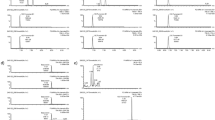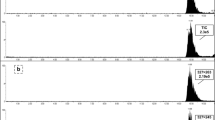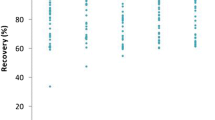Abstract
This study is the first report of applying an ultra high performance liquid chromatography/tandem mass spectrometric (UHPLC-MS/MS) multi-mycotoxin method to identify and quantify the mycotoxins produced by pure fungal isolates grown on Yeast Extract Sucrose (YES) agar. The method developed concerns a triple extraction procedure based on methanol, dichloromethane and ethyl acetate. The total extract was chromatographically separated on an UHPLC BEH C18 column and analyzed with a triple quadrupole mass spectrometer. Performance characteristics (specificity, linearity, possible matrix effects, recovery, repeatability, reproducibility and limit of detection) were evaluated by spiking experiments with blank agar plugs and the analytes. Verrucarol was used as internal standard. Recovery percentages varied between 56 and 125%, whereas the limit of detection ranged from 1 to 1,500 ng g−1 with the exception of NIV, PAT and ZEA. The method was successfully applied for examining the in vitro mycotoxin production by Aspergillus fumigatus, A. flavus and A. niger. The mobile phases used for chromatographic separation were slightly modified when studying patulin-producing molds due to signal interference between this mycotoxin and an unknown metabolite. This modified method was successfully applied for Penicillium roqueforti, P. paneum and P. carneum grown on YES agar medium. Application of the multi-mycotoxin UHPLC-MS/MS method developed may be of great importance for studying the mycotoxin capacity of fungal isolates under varying growth conditions, in order to obtain a better insight into the conditions which induce or suppress mycotoxin production by pure fungal isolates or from a chemotaxonomic point of view.



Similar content being viewed by others
References
Beltran E, Ibanez M, Sancho JV, Hernandez F (2009) Determination of mycotoxins in different food commodities by ultra-high-pressure liquid chromatography coupled to triple quadrupole mass spectrometry. Rapid Commun Mass Spectrom 23:1801–1809
Bennet JW, Klich M (2003) Mycotoxins. Clin Microbiol Rev 16:497–516
Berger U, Oehme M, Kuhn F (1999) Quantitative determination and structure elucidation of type A- and B-trichothecenes by HPLC/ion trap multiple mass spectrometry. J Agric Food Chem 47:4240–4245
Berthiller F, Schuhmacher R, Buttinger G, Krska R (2005) Rapid simultaneous determination of major type A- and B-trichothecenes as well as zearalenone in maize by high performance liquid chromatography-tandem mass spectrometry. J Chromatogr A 1062:209–216
Betina V (1984) Biological effects of mycotoxins. In: Betina V (ed) Mycotoxins-production, isolation, separation and purification. Elsevier, Amsterdam, pp 25–36
Bird BA, Campbell IM (1982) Disposition of mycophenolic acid, brevianamide A, asperphenamate and ergosterol in solid cultures of Penicillium brevicompactum. Appl Environ Microbiol 43:345–348
Biselli S, Hummert C (2005) Development of a multicomponent method for Fusarium toxins using LC-MS/MS and its application during a survey for the content of T-2 toxin and deoxynivalenol in various feed and food samples. Food Addit Contam 22:752–760
Biselli S, Gartig L, Wegner H, Hummert C (2004) Analysis of Fusarium toxins using LC/MS-MS: application to various food and feed matrices. LC-GC Europe 17:25–30
Boysen M, Skouboe P, Frisvad J, Rossen L (1996) Reclassification of the Penicillium roqueforti group into three species on the basis of molecular genetic and biochemical profiles. Microbiology 142:541–549
Byrem TM, Pestka JJ, Chu FS, Strasburg GM (1999) Analysis and pharmacokinetics of cyclopiazonic acid in market weight pigs. J Anim Sci 77:173–179
Cavaliere C, Foglia P, Pastorini E, Samperi R, Lagana A (2005) Development of a multiresidue method for analysis of major Fusarium mycotoxins in corn meal using liquid chromatography/tandem mass spectrometry. Rapid Commun Mass Spectrom 19:2085–2093
Delmulle B, De Saeger S, Adams A, De Kimpe N, Van Peteghem C (2006) Development of a liquid chromatography/tandem mass spectrometry method for the simultaneous determination of 16 mycotoxins on cellulose filters and in fungal cultures. Rapid Commun Mass Spectrom 20:771–776
Di Mavungu JD, Monbaliu S, Scippo ML et al (2009) LC-MS/MS multi-analyte method for mycotoxin determination in food supplements. Food Addit Contam A Chem Anal Control Expo Risk Assess 26:885–895
D'Mello JPE, MacDonald AMC (1997) Mycotoxins. Anim Feed Sci Technol 69:155
Filtenborg O, Frisvad JC, Svendsen JA (1983) Simple screening method for molds producing intracellular mycotoxins in pure cultures. Appl Environ Microbiol 45:581–585
Fink-Gremmels J (1999) Mycotoxins: their implications for human and animal health. Vet Ext Q 21:115–120
Fink-Gremmels J (2008) Mycotoxins in cattle feeds and carry-over to dairy milk: a review. Food Addit Contam 25:172–180
Frisvad JC, Filtenborg O (1983) Classification of Terverticillate Penicillia based on profiles of myco-toxins and other secondary metabolites. Appl Environ Microbiol 46:1301–1310
Gilbert J, Anklam E (2002) Validation of analytical methods for determining mycotoxins in foodstuffs. Trends Anal Chem 21:468–486
Hussein HS, Brasel JM (2001) Toxicity, metabolism, and impact of mycotoxins on humans and animals. Toxicology 167:101–134
Jiang J, Yan L, Ma Z (2009) Molecular characterization of an atoxigenic Aspergillus flavus strain AF051. Appl Microbiol Biotechnol 83:501–505
Klotzel M, Lauber U, Humpf HU (2006) A new solid phase extraction clean-up method for the determination of 12 type A and B trichothecenes in cereals and cereal-based food by LC-MS/MS. Mol Nutr Food Res 50:261–269
Kokkonen M, Jestoi M, Rizzo A (2005) Determination of selected mycotoxins in mould cheeses with liquid chromatography coupled to tandem with mass spectrometry. Food Addit Contam 22:449–456
Kupfahl C, Michalka A, Lass-Floerl C et al (2008) Gliotoxin production by clinical and environmental Aspergillus fumigatus strains. Int J Med Microbiol 298:319–327
Monbaliu S, Van Poucke C, Van Peteghem C, Van Poucke K, Heungens K, De Saeger S (2009) Development of a multi-mycotoxin liquid chromatography/tandem mass spectrometry method for sweet pepper analysis. Rapid Commun Mass Spectrom 23:3–11
Monbaliu S, Van Poucke C, Detavernier C et al (2010) Occurrence of mycotoxins in feed as analyzed by a multi-mycotoxin LC-MS/MS method. J Agric Food Chem 58:66–71
Norred WP, Porter JK, Dorner JW, Cole RJ (1998) Occurrence of the mycotoxin cyclopiazonic acid in meat after oral administration to chickens. J Agric Food Chem 36:113–116
Peraica M, Radic B, Lucic A, Pavlovic M (1999) Toxic effects of mycotoxins in humans. Bull World Health Organ 77:754–766
Plattner RD, Maragos CM (2003) Determination of deoxynivalenol and nivalenol in corn and wheat by liquid chromatography with electrospray mass spectrometry. J AOAC Int 86:61–65
Rasmussen RR, Storm IMLD, Rasmussen PH, Smedsgaard J, Nielsen KF (2010) Multi-mycotoxin analysis of maize silage by LC-MS/MS. Anal Bioanal Chem 397:765–776
Razzazi-Fazeli E, Bohm J, Luf W (1999) Determination of nivalenol and deoxynivalenol in wheat using liquid chromatography-mass spectrometry with negative ion atmospheric pressure chemical ionisation. J Chromatogr A 854:45–55
Razzazi-Fazeli E, Rabus B, Cecon B, Bohm J (2002) Simultaneous quantification of A-trichothecene mycotoxins in grains using liquid chromatography atmospheric pressure chemical ionisation mass spectrometry. J Chromatogr A 968:129–142
Ren YP, Zhang Y, Shao SL, Cai ZX, Feng L, Pan HF, Wang ZG (2007) Simultaneous determination of multi-component mycotoxin contaminants in foods and feeds by ultra-performance liquid chromatography tandem mass spectrometry. J Chromatogr A 1143:48–64
Richard E, Heutte N, Sage L, Pottier D, Bouchart V, Lebailly P, Garon D (2007) Toxigenic fungi and mycotoxins in mature corn silage. Food Chem Toxicol 45:2420–2425
Rosinska D, Vierikova M, Lehotay J (2009) Determination of patulin in apple products using HPLC with photodiode array detector and ultra performance liquid chromatography with electrospray-tandem mass spectrometry. J Liq Chromatogr Relat Technol 32:500–511
Royer D, Humpf HU, Guy PA (2004) Quantitative analysis of Fusarium mycotoxins in maize using accelerated solvent extraction before liquid chromatography atmospheric pressure chemical ionization tandem mass spectrometry. Food Addit Contam 21:678–692
Samson RA, Hoekstra ES, Frisvad JC (2004) Mycological media. In: Samson RA, Hoekstra ES, Frisvad JC (eds) Introduction of food- and airborne fungi. Ponsen & Looyen, Wageningen, pp 378–381
Smedsgaard J (1997) Micro-scale extraction procedure for standardized screening of fungal metabolite production in cultures. J Chromatogr A 760:264–270
Sorensen LK, Elbaek TH (2005) Determination of mycotoxins in bovine milk by liquid chromatography tandem mass spectrometry. J Chromatogr B Analyt Technol Biomed Life Sci 820:183–196
Spanjer MC, Rensen PM, Scholten JM (2008) LC-MS/MS multi-method for mycotoxins after single extraction, with validation data for peanut, pistachio, wheat, maize, cornflakes, raisins and figs. Food Addit Contam A Chem Anal Control Expo Risk Assess 25:472–489
Sulyok M, Berthiller F, Krska R, Schuhmacher R (2006) Development and validation of a liquid chromatography/tandem mass spectrometric method for the determination of 39 mycotoxins in wheat and maize. Rapid Commun Mass Spectrom 20:2649–2659
Sulyok M, Krska R, Schuhmacher R (2007) A liquid chromatography/tandem mass spectrometric multi-mycotoxin method for the quantification of 87 analytes and its application to semi-quantitative screening of moldy food samples. Anal Bioanal Chem 389:1505–1523
Tuomi T, Saarinen L, Reijula K (1998) Detection of polar and macrocyclic trichothecene mycotoxins from indoor environments. Analyst 123:1835–1841
Vasanthi S, Bhat RV (1998) Mycotoxins in foods - occurrence, health & economic significance & food control measures. Indian J Med Res 108:212–224
Veldman A, Meijs JAC, Borggreve GJ, Heeresvandertol JJ (1992) Carry-over of aflatoxin from cows food to milk. Anim Prod 55:163–168
Acknowledgments
We are grateful to Mieke Van Tomme, Petra De Neve, Patricia Van Herreweghe, Luc Batjoens, and Els Verween for their excellent technical assistance. The research was funded by a PhD grant (IWT-SB/63435) of the Agence for Innovation by Science and Technology in Flanders (IWT).
Author information
Authors and Affiliations
Corresponding author
Rights and permissions
About this article
Cite this article
Van Pamel, E., Vlaemynck, G., Heyndrickx, M. et al. Mycotoxin production by pure fungal isolates analysed by means of an uhplc-ms/ms multi-mycotoxin method with possible pitfalls and solutions for patulin-producing isolates. Mycotox Res 27, 37–47 (2011). https://doi.org/10.1007/s12550-010-0073-4
Received:
Revised:
Accepted:
Published:
Issue Date:
DOI: https://doi.org/10.1007/s12550-010-0073-4




